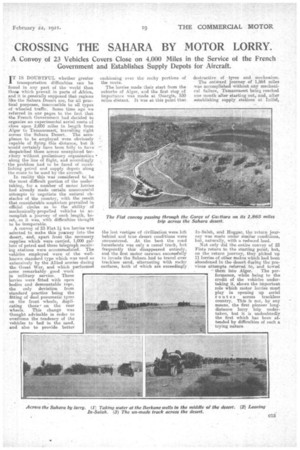CROSSING THE SAHARA BY MOTOR LORRY.
Page 19

If you've noticed an error in this article please click here to report it so we can fix it.
A Convoy of 23 Vehicles Covers Close on 4,000 Miles in the Service of the French Government and Establishes Supply Depots for Aircraft.
IT IS DOUBTFUL whether greater transportation difficulties can be found in any part of the world than those which prevail in parts of Africa, and it is generally supposed that regions like the Sahara Desert axe, for all practical purposes, inaccessible to all types of wheeled traffic. Some time ago we referred in our pages to the fact that the French Government had decided to organize an experimental aerial route of close upon 2,000 miles in length from Alger to Tamanrasset, travelling right across the Sahara Desert. The aeroplanes to be employed were obviously capable of flying this distance, but it would certainly have been folly to have despatched them across unexplored territory without preliminary organization along the line of flight, and accordingly the problem had to be faced of establishing petrol and supply depots along the route to be used by the aircraft. In reality this was considered to be the most difficult portion of the undertaking, for a number of motor lorries had already made certain unsuccessful attempts to negotiate the natural obitack-a of the country, with the result that considerable scepticism prevailed in official circles as to the abilityof nrechanie.ally-propelled vehicles to accomplish a journey of such length, beset.,, as it was, with difficulties thought to be in.s-nperable. A Convoy of 23 Fiat 1 ton lorries was selected to make this journey into the desert, and, apart from the necessary supplies which were carried, 1,000 gallons of petrol and three telegraph receiving stations were accommodated. The vehicles employed were of the wellknown standard type which was used so extensively by the Allied armies during the Great War, and which performed some remarkably good work in military service. These lorries were fitted with open bodies and demountable tops, the only deviation from standard practice being the fitting of dual pneumatic tyres on the front wheels, duplicating thoseon the rear wheels. This change was thought advisable in order to oveitionte the tendency of the vehicles to bed in the sand, and also to provide better
cushioning over the rocky portions of the route.
The lorries made their start from the suburbs of Alger, and the first stop of importance was made at Ouargla, 530 miles distant. It was at this point that the last vestiges, of civilization were left behind and true desert conditions were encountered. At the best the road hereabouts was only a came/ track, but frequently this disappeared entirely, and the first motor caravan successfully to invade the Sahara had to travel over trackless sand, alternating With rocky surfaces, both of which are exceedingly destructive of tyres and mechanism. The outward journey of 1,864 miles was accomplished without any mechanical failure, Tamanrasset being reached one month after starting out, and, after establishing supply stations at Inifel, In-SaIah, and Hoggar, the return journey was made under similar conditions, hut, naturally, with a reduced load. Not only did the. entire convoy of 23 Fiats return to the starting point, but, on the return journey, they picked up 11 lorries of other Makes which had been abandoned in the desert during the previous attempts referred to, and towed.
-• them into Alger. The performance, while being to the credit of the vehicles undertaking it, shows the important role which motor lorries must play in opening up aerial routes • across trackless country. This is not, by any means, the first pioneer longdistance lorry trip undertaken, but it is undoubtedly the first which has been attended by difficulties of such a trying nature






























